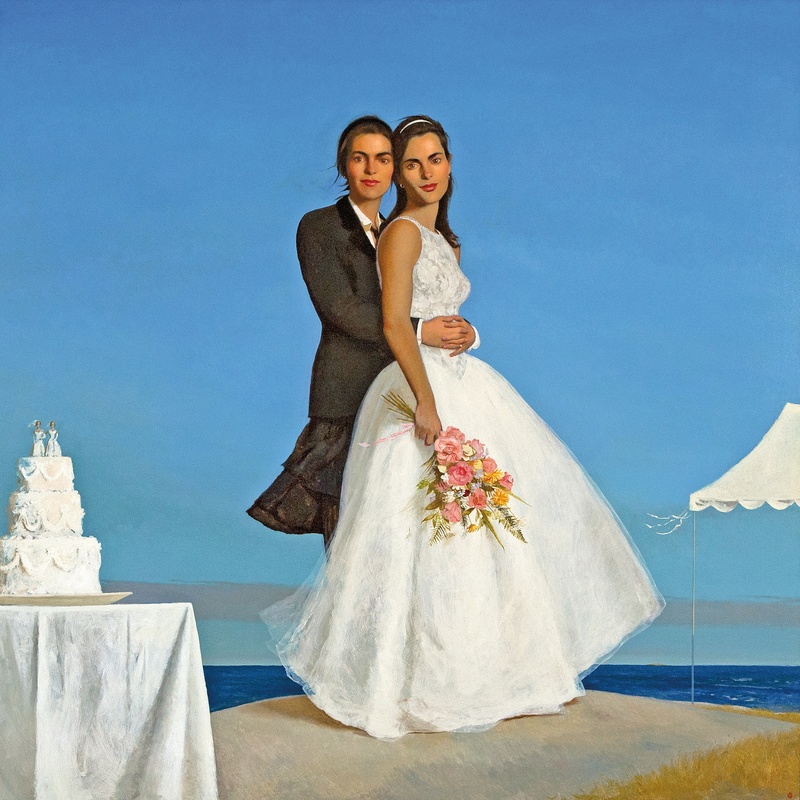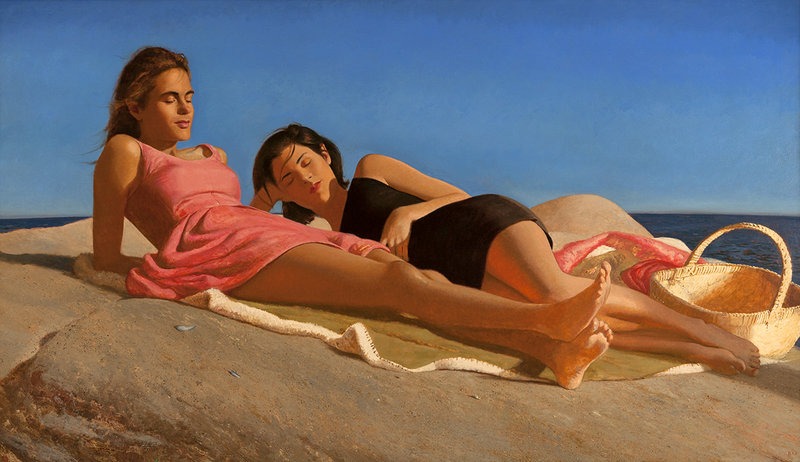ROCKLAND — Without a doubt, Bo Bartlett’s “Love and Other Sacraments” at Dowling Walsh Gallery is one of Maine’s most interesting gallery shows of 2013.
It’s a major show by an internationally significant Maine-rooted artist at one of the state’s largest and highest profile galleries. But the critical timing of the show’s subjects is what makes this combination more than just another heap of superlatives.
Bartlett is what most people think of as a realist painter. He often works on a large scale, and tends to obsessively revisit a few models – most notably his wife, the striking and talented painter Betsy Eby (whose paintings I have long liked more than Bartlett’s).
While Bartlett considers himself to follow in the artistic tracks of his mentor-of-sorts, Andrew Wyeth, his works follow a path of finish, scale, self-importance and narrative figuration more in the vein of the muscularly gigantic “Salon machines” that ruled the Louvre throughout the 19th century.
With so many images of women couples and wedding dresses, the underlying content of the show unquestionably rides the sparkling tsunami of same-sex marriage in America.
I have no doubt about the importance of Bartlett’s subject, but I am still deeply conflicted about “Love and Other Sacraments.”
First of all, Bartlett can be downright annoying. One smaller painting features a Stephen Etnier-like coastal shack seen from the driver’s seat of a car – looking over a Mercedes Benz hood ornament. It’s hardly subtle.
The bigger off-message – and more cloying – gesture of the show is the series of eight monochrome, blue sky paintings.
These force you to look to the labels for context, and they offer titles such as “September 11, 2012, Wheaton Island” – and, more jarringly, prices of $30,000 each for 18-inch square paintings.
So while Bartlett no doubt wants to represent himself as thinking profound thoughts on important days, these works do more to announce that he’s big-time enough that his paintings are priced by size.
Bartlett leaves the clip marks evidencing these were painted en plein air, but this only removes them with certainty from great monochrome painting by the likes of Reinhardt or Malevich (though it reminds me of Yves Klein’s brilliantly flippant exhibition, in which the titles of his blue monochromes were their prices). There is a long history of sky studies, so these only rise to the level of original via Bartlett’s willingness to cash in on 9/11.
And yet, Bartlett can be gloriously subtle.
His “The Promise” shows two women in sundresses lying together on Maine coastal rocks, their eyes closed to imagine how their new commitment ties the future permanently to the present, and vice versa.
My favorite gesture in the show has these two women (in the style of Ingres) lying together in bed with a foreground bedside table drawer slightly opened, giving a delicious hint of boudoir accoutrements. I also like the play of the title “Verisimilitude” (realistic painting) for two women posing as lovers in bed: They aren’t real lesbians, but look just like them. This does have the effect, however, of infecting the show with smug theatricality.
Staging for content and composition is one thing, but Bartlett’s theatricality feels like he prefers to fool the audience; the models aren’t his muses, but his shills.
One image of Bartlett’s wife lying, dressed this time, with the blond model clearly exudes the creepiness that pervades the entire show. But rather than the distant cultural threats recalled by the title “Outside This Room Is War and Terror,” the active ingredient is a mistake of painting — the bodies are recumbent, but the faces seem to have been painted from upright models.
While it’s only because he sets the bar so high, Bartlett stumbles on this kind of awkwardness — when a far leg doesn’t fit when added after to make a lover seem to lie between the other’s legs in “A Brief History of an Afternoon”; when a hand on a lover’s arm appears as an unconvincing afterthought in “Oceans,” a painting that furthers a sense of theatrical affect with the impossible perspective of the ocean pushing up and under the window like a stage backdrop.
While Bartlett’s approach is anchored in narrative painting, he prefers enigma to clarity. Yet compelling enigmas mobilize perplexing ironies, semiotic misfires and intentional incompatibilities rather than leaving dots off i’s and crosses off t’s. It’s not an enigma simply because something is incomplete or doesn’t make sense.
But this is Bartlett’s narrative aesthetic: It requires a taste for the open-ended. If you see poetics in that, then all the better. And Bartlett’s nods to Magritte, Dali and de Chirico succeed in hinting that he is something other than a realist painter.
Bartlett’s obsession with his wife adds to the show’s creepiness. Despite her model beauty, one of Eby’s defining features is a slight black moustache. The pervasiveness of this unsettlingly echoes the narcissistic self-involvement of Frida Kahlo.
This comes full-circle with “The Big Day,” in which Eby appears to marry herself – dressed as a bride and then as a female groom in a skirt. It’s an interesting painting, what with the two brides in dresses on the cake (veils flowing right to left – like in all of Bartlett’s paintings) and the dream-like setting. But it didn’t work for Dennis Rodman, and it doesn’t work here.
Despite my grievances, “Love and Other Sacraments” is a serious and deeply interesting show.
Bartlett can handle a brush, and he knows how to make a big painting. Plus, this show is on a scale that maybe only Dowling Walsh could pull off in Maine; the gallery, after all, is huge, gorgeous and chock-a-block with noteworthy artists like Alan Magee, Connie Hayes and (now) Eric Hopkins.
While I question Bartlett’s heart, I support his subject: What, after all, is a better cause than love?
Freelance writer Daniel Kany is an art historian who lives in Cumberland. He can be contacted at:
dankany@gmail.com
Send questions/comments to the editors.




Success. Please wait for the page to reload. If the page does not reload within 5 seconds, please refresh the page.
Enter your email and password to access comments.
Hi, to comment on stories you must . This profile is in addition to your subscription and website login.
Already have a commenting profile? .
Invalid username/password.
Please check your email to confirm and complete your registration.
Only subscribers are eligible to post comments. Please subscribe or login first for digital access. Here’s why.
Use the form below to reset your password. When you've submitted your account email, we will send an email with a reset code.